Fuzzy Damage Analysis of the Seismic Response of a Long-Distance Pipeline under a Coupling Multi-Influence Domain
Abstract
1. Introduction
2. Ground Motion of the Random Field
2.1. Definition of Random Fields
2.2. Model of Random Fields
2.3. Pipeline Random Field Model Based on Statistical Data
3. Random Process of Ground Motion
3.1. Definition of a Nonstationary Earthquake Random Process
3.2. Random Process Model of Ground Motion and Its Orthogonal Development
3.2.1. Random Process Model of Ground Motion
3.2.2. Orthogonal Expansion of Random Processes of Ground Motion
3.3. Orthogonal Expansion of the Clough-Penzien Model Based on an Orthonormal Basis
4. Random Space-time Earthquake Load Considering Site Conditions
5. Response Analysis of Long-Distance Pipelines under a Random Space-Time Earthquake
5.1. Computational Assumptions
- The quality of the pipeline is concentrated on the node;
- We ignore the influence of the rotational component of the ground motion;
- The absolute coordinate system is relative static to the geocentric;
- The damping force is proportional to the relative velocity.
5.2. Equation of Motion
5.3. Response Analysis of a Buried Pressure Pipeline
6. Numerical Simulation and Analysis
6.1. Structural Model and Earthquake Model
6.2. Finite Element Model
6.3. Comparison and Analysis of Results
7. Fuzzy Damage Analysis of the Pipeline
7.1. Fuzzy Damage Model
7.2. Application of Pipeline Analysis
8. Conclusions
- Using random processes and random fields, the coupling of a universal stochastic space-time earthquake load based on the power spectrum is investigated, and the seismic load of space-time characteristics is summarized.
- For long-distance pipelines, under the action of earthquake loads, it is necessary to consider not only the time-varying characteristics with time but also the factors brought about by the spatial characteristics. Due to the influence of spatial factors on the long-distance pipeline, relative to non-uniform excitation, the result will be quite different.
- The response of a long-distance pipeline under nonuniform earthquake excitation is solved, and it is of great significance to establish the response design system for a long-distance pipeline under an earthquake.
- Establishing the fuzzy damage model of the pipeline and the fuzzy safety criterion can more reasonably describe the damage of the structure with a certain level or higher level. This approach has laid the foundation for the establishment of comprehensive assessment of pipeline safety in the future.
Author Contributions
Acknowledgments
Conflicts of Interest
References
- Wen, K.; He, L.; Yu, W.; Gong, J. A Reliability Assessment of the Hydrostatic Test of Pipeline with 0.8 Design Factor in the West-East China Natural Gas Pipeline III. Energies 2018, 11, 1197. [Google Scholar] [CrossRef]
- He, B.J.; Zhao, D.X.; Zhu, J.; Darko, A.; Gou, Z.H. Promoting and implementing urban sustainability in China: An integration of sustainable initiatives at different urban scales. Habitat Int. 2018, 82, 83–93. [Google Scholar] [CrossRef]
- Mou, B.; He, B.J.; Zhao, D.X.; Chau, K.W. Numerical simulation of the effects of building dimensional variation on wind pressure distribution. Eng. Appl. Comput. Fluid 2017, 11, 293–309. [Google Scholar] [CrossRef]
- Zhang, Z.C.; Lin, J.H.; Zhang, Y.H.; Zhao, Y.; Howson, W.P.; Williams, F.W. Non-stationary random vibration analysis for train–bridge systems subjected to horizontal earthquakes. Eng. Struct. 2010, 32, 3571–3582. [Google Scholar] [CrossRef]
- CEM. Eurocode 8: Design of Structure for Earthquake Resistance-Part 2: Bridges: European Standard EN 1998-2: 2005; Comite European de Normalisation: Brusells, Belgium, 2005. [Google Scholar]
- Hindy, A.; Novak, M. Pipeline response to stochastic ground motion. J. Eng. Mech. Div. 1980, 106, 339–360. [Google Scholar]
- Loh, C.H. Analysis of the spatial variation of earthquake waves and ground movements from smart-1 array data. Earthq. Eng. Struct. Dyn. 2010, 13, 561–581. [Google Scholar] [CrossRef]
- Wan, Y. Orthogonal Expansion-Stochastic Function Model of Engineering Stochastic Excitation and Its Application; Three Gorges University: Yi Chang, China, 2014. [Google Scholar]
- Li, J.; Liu, Z.J. Stochastic process expansion method based on standard orthogonal basis. J. Tongji Univ. (Nat. Sci. Ed.) 2006, 3410, 1279–1283. [Google Scholar] [CrossRef]
- Liu, Z.J.; Li, J. Orthogonal expansion of stochastic processes of ground motion. J. Tongji Univ. (Nat. Sci. Ed.) 2008, 36, 1153–1159. [Google Scholar] [CrossRef]
- He, X.; Zhao, H.; Cai, W.; Liu, Z.; Si, S.Z. Earthquake networks based on space–time influence domain. Phys. A Stat. Mech. Appl. 2014, 407, 175–184. [Google Scholar] [CrossRef]
- Zadeh, L.A. Fuzzy sets. Inf. Control 1965, 8, 338–353. [Google Scholar] [CrossRef]
- Jamshidi, A.; Yazdani-Chamzini, A.; Yakhchali, S.H.; Khaleghi, S. Developing a new fuzzy inference system for pipeline risk assessment. J. Loss Prev. Process. Ind. 2013, 26, 197–208. [Google Scholar] [CrossRef]
- Markowski, A.S.; Mannan, M.S. Fuzzy logic for piping risk assessment (pflopa). J. Loss Prev. Process. Ind. 2009, 22, 921–927. [Google Scholar] [CrossRef]
- Lazarian, A.; Vishniac, E.T. Reconnection in a weakly stochastic field. Astrophys. J. 2012, 517, 700–718. [Google Scholar] [CrossRef]
- Ye, J.H.; Zhang, Z.Q.; Chu, Y. Strength behavior and collapse of spatial-reticulated structures under multi-support excitation. Sci. China Technol. Sci. 2011, 54, 1624–1638. [Google Scholar] [CrossRef]
- Ye, J.; Pan, J.; Liu, X. Vertical coherency function model of spatial ground motion. Earthq. Eng. Eng. Vib. (Engl. Vers.) 2011, 10, 403. [Google Scholar] [CrossRef]
- Bi, K.; Hao, H. Influence of irregular topography and random soil properties on coherency loss of spatial seismic ground motions. Earthq. Eng. Struct. Dyn. 2011, 40, 1045–1061. [Google Scholar] [CrossRef]
- Shinozuka, M.; Saxena, V.; Deodatis, G. Effect of spatial variation of ground motion on highway structures. Caries Res. 2000, 42, 79–87. [Google Scholar] [CrossRef]
- Luco, J.; Wong, H. Response of a rigid foundation to a spatially stochastic ground motion. Earthq. Eng. Struct. Dyn. 1986, 14, 891–908. [Google Scholar] [CrossRef]
- Wiener, N. Generalized harmonic analysis. Acta Math. 1930, 55, 117–258. [Google Scholar] [CrossRef]
- Clough, R.W.; Penzien, J. Dynamics of Structures; McGraw-Hill: New York, NY, USA, 1993. [Google Scholar]
- Ma, X.; Vakakis, A.F.; Bergman, L.A. Karhunen–Loeve analysis and order reduction of the transient dynamics of linear coupled oscillators with strongly nonlinear end attachments. J. Sound Vib. 2008, 309, 569–587. [Google Scholar] [CrossRef]
- Seya, H.; Talbott, M.E.; Hwang, H.H.M. Probabilistic earthquake analysis of a steel frame structure. Probab. Eng. Mech. 1993, 8, 127–136. [Google Scholar] [CrossRef]
- Dumanogluid, A.A.; Soyluk, K. A stochastic analysis of long span structures subjected to spatially varying ground motions including the site-response effect. Eng. Struct. 2003, 25, 1301–1310. [Google Scholar] [CrossRef]
- Yan, S.H.; Liang, B.; Gao, F. Dynamic reliability analysis of resistance of tunnels longitudinal non-stationarity earthquake. J. Rock Mech. Eng. 2005, 24, 818–822. [Google Scholar] [CrossRef]
- Cao, Z.; Xue, S.D.; Wang, X.S.; Liu, Y.C. Selection of earthquake waves and values of damping ratio for space structures in aseismic analysis. Spat. Struct. 2008, 14, 3–8. [Google Scholar] [CrossRef]
- Davenport, A.G. Note on the distribution of the largest value of a random function with application to gust loading. Proc. Inst. Civ. Eng. 1964, 28, 187–196. [Google Scholar] [CrossRef]
- Lin, J.; Li, J.; Zhang, W.; Williams, F.W. Non-stationary stochastic earthquake responses of multi-support structures in evolutionary inhomogeneous stochastic fields. Earthq. Eng. Struct. Dyn. 1997, 26, 135–145. [Google Scholar] [CrossRef]
- Bubenik, T.A.; Olson, R.J.; Stephens, D.R.; Francini, R.B. Analyzing the Pressure Strength of Corroded Line Pipe; Offshore Mechanics and Arctic Engineering: Calgary, AB, Canada, 1992. [Google Scholar]
- Flügge, W. Handbook of Engineering Mechanics; McGraw-Hill: New York, NY, USA, 1962. [Google Scholar]
- Ye, L.P.; Lu, X.Z. Analysis on seismic damage of building in the Wenchuan earthquake. J. Archit. Struct. 2008, 29, 1–9. [Google Scholar] [CrossRef]
- Rimkevicius, S.; Kaliatka, A.; Valincius, M.; Dundulis, G.; Janulionis, R.; Grybenas, A.; Zutautaite, I. Development of approach for reliability assessment of pipeline network systems. Appl. Energy 2012, 94, 22–33. [Google Scholar] [CrossRef]
- Urban Construction Research Institute. CJJ/T 81-2013 Technical Specification for Directly Buried Hot Water Pipeline for Urban Heating; China Building Industry Press: Beijing, China, 2013. [Google Scholar]
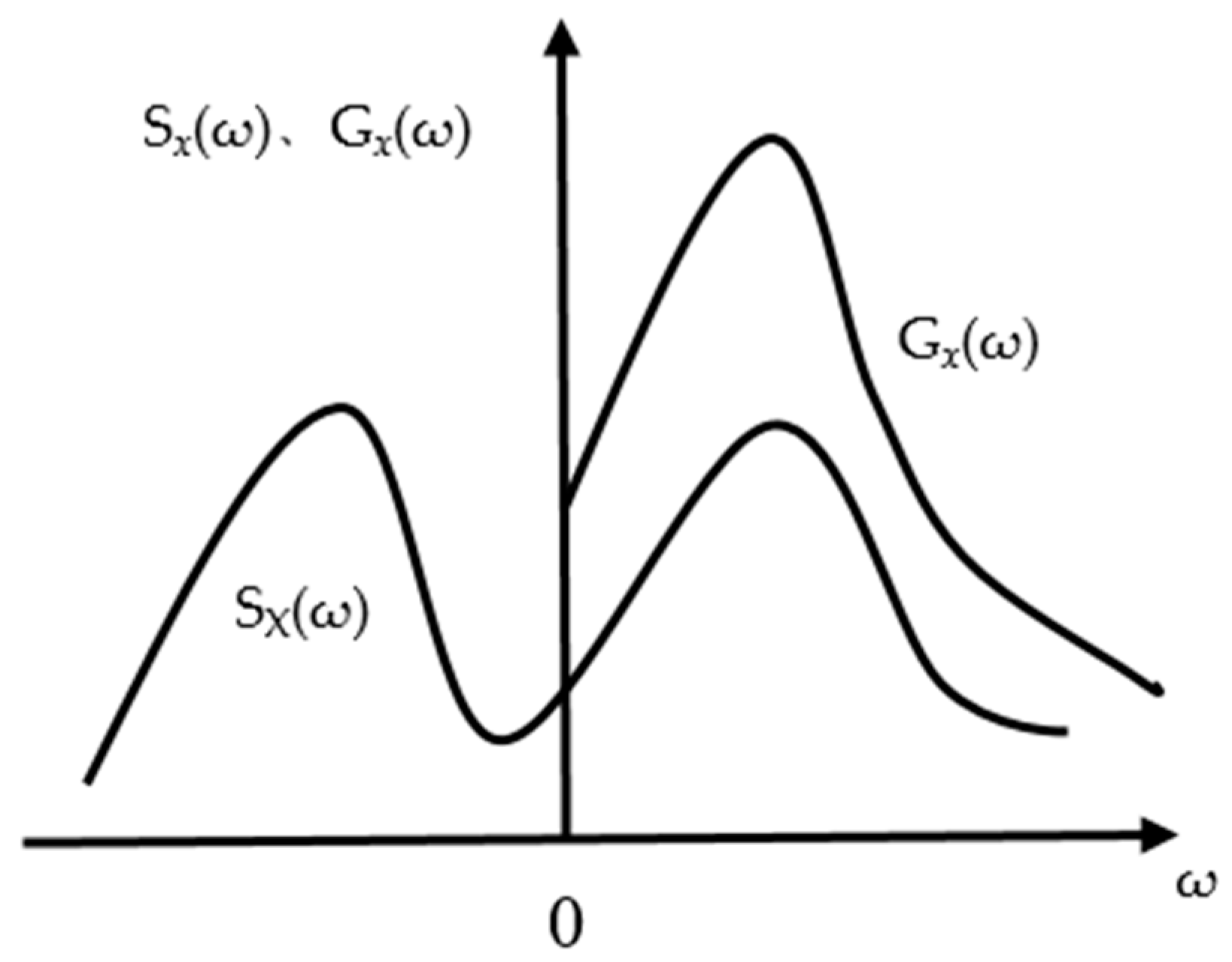

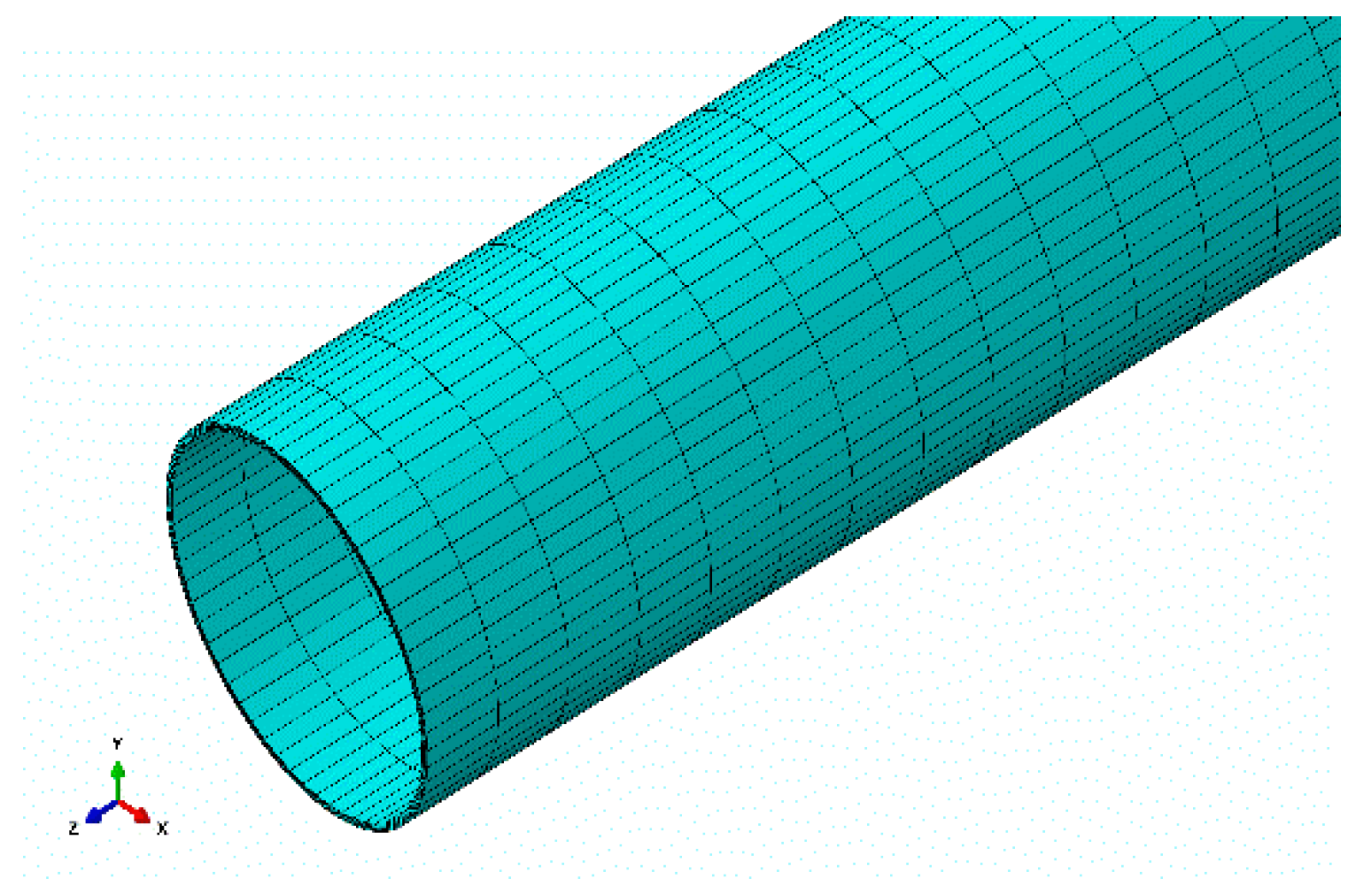



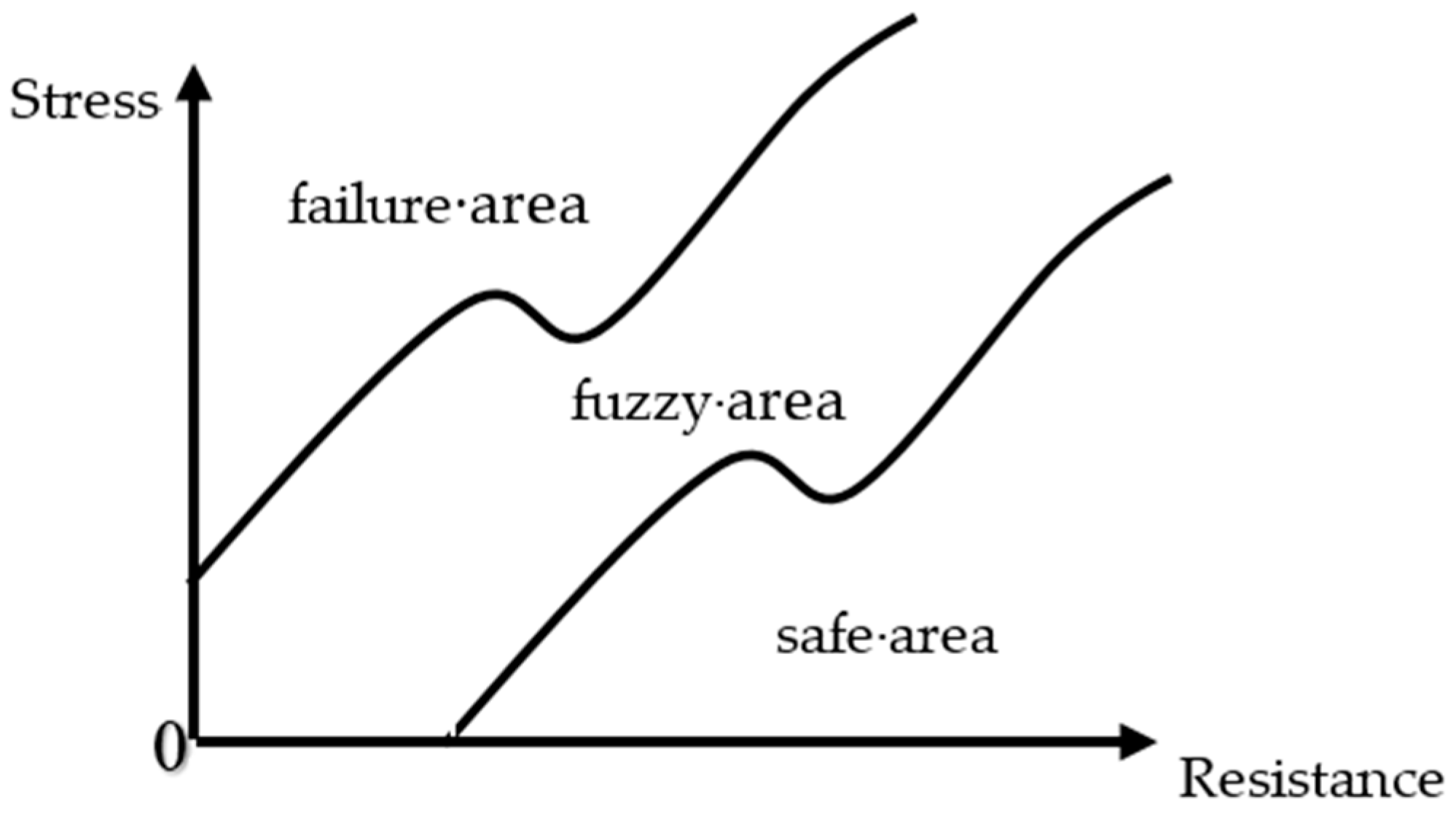
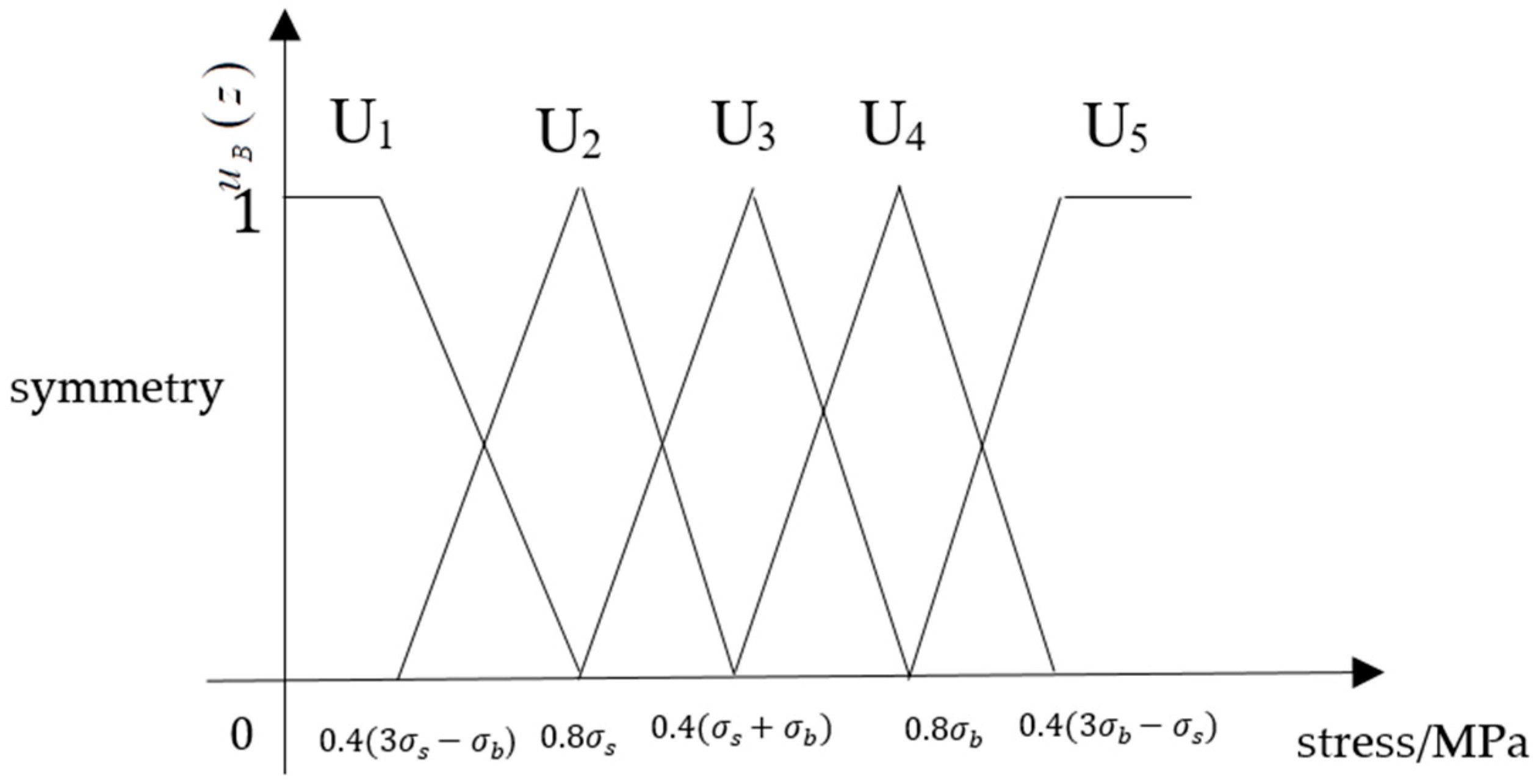


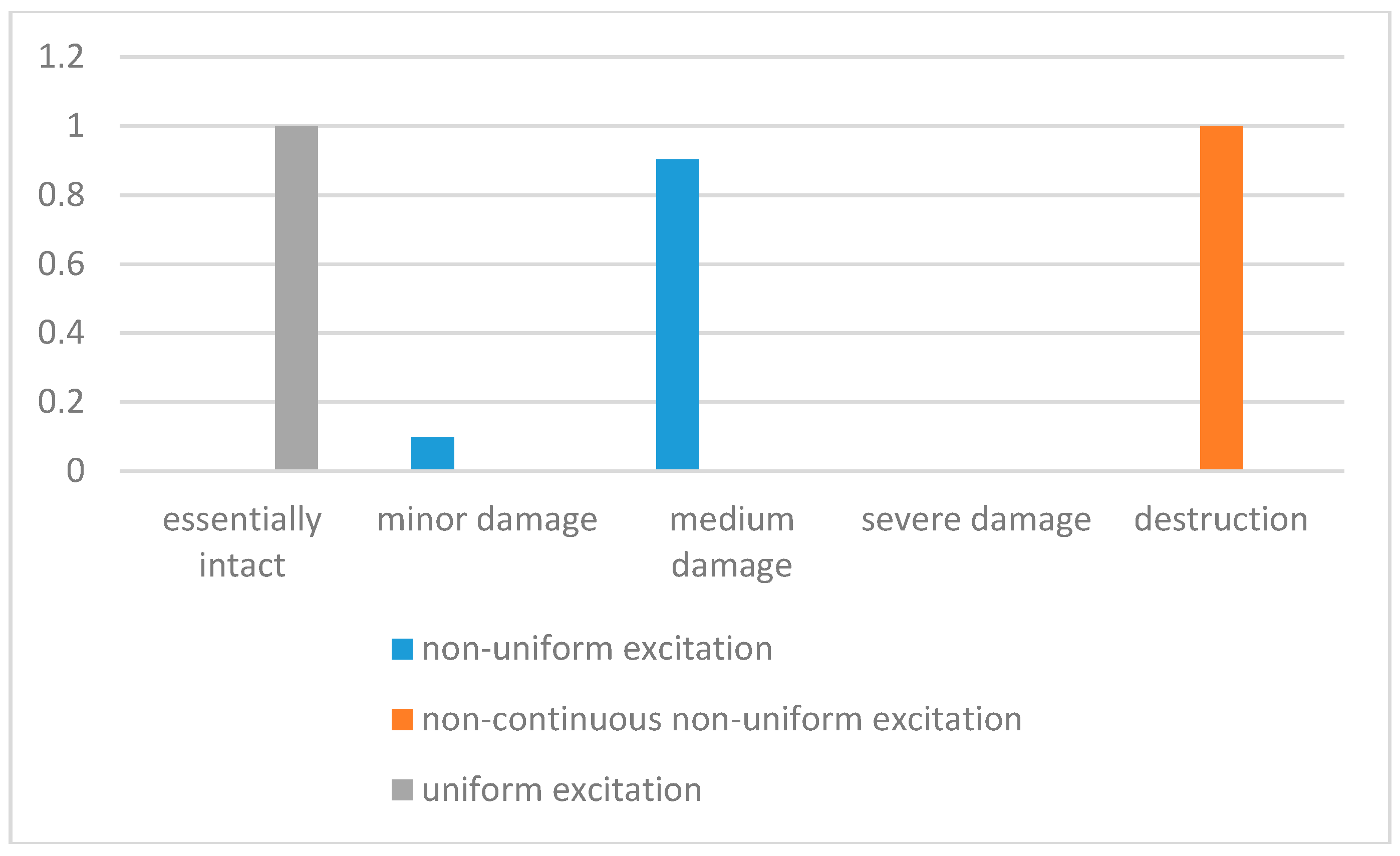
| Site Category | Spectral Intensity Factor S0 | Peak Factor f | ωe | Maximum Acceleration |
|---|---|---|---|---|
| Hard soil site | 54.14 | 3.0 | 78.84 | 196 (0.2 g) |
| Medium soil site | 81.15 | 3.1 | 49.26 | 196 (0.2 g) |
| Weak soil site | 145.98 | 3.2 | 25.70 | 196 (0.2 g) |
| Site Category | ωg | ωf | ξg | ξf |
|---|---|---|---|---|
| Hard soil site | 8π | 0.8π | 0.60 | 0.60 |
| Medium soil site | 5π | 0.5π | 0.60 | 0.60 |
| Weak soil site | 2.4π | 0.24π | 0.85 | 0.85 |
| Site Category | Expand Items N | Truncated Items n |
|---|---|---|
| Hard soil site | 500 | 10 |
| Medium soil site | 500 | 10 |
| Weak soil site | 500 | 10 |
| Structure Type | Combined Site Type | ||
|---|---|---|---|
| I-II | II-III | III-IV | |
| Single dimension and single span | 1.20 | 1.15 | 1.22 |
| Multidimension and multispan | 1.32 | 1.27 | 1.34 |
| Material | Diameter of Pipeline/mm | Elastic Modulus/GPa | Poisson Ratio | Wall Thickness/mm | Yield Ttress/MPa |
|---|---|---|---|---|---|
| X60 | 457 | 207 | 0.3 | 28.7 | 423 |
| Material Category | Density/ (kg·m−3) | Elastic Modulus/Pa | Poisson Ratio | Expansion Angle/° | Friction Angle/° | Flow Stress Ratio |
|---|---|---|---|---|---|---|
| soil | 1867.3 | 2 × 108 | 0.4 | 28.7 | 18.4 | 0 |
| pipeline | 7850 | 2.07 × 1011 | 0.3 | - | - | - |
| Earthquake Damage Level | Description | Quantitative Indicators |
|---|---|---|
| Essentially intact | The pipe may be slightly deformed, but it is not damaged, there is no leakage, and it can continue to operate without repair. | |
| Medium damage | Large deformation or buckling of the pipeline, slight damage, leakage, affecting the gas supply but allowing resumption of operation after emergency repair. | |
| Severe damage | The pipe is broken, and the interface is pulled off, causing secondary disasters and requiring replacement. |
© 2018 by the authors. Licensee MDPI, Basel, Switzerland. This article is an open access article distributed under the terms and conditions of the Creative Commons Attribution (CC BY) license (http://creativecommons.org/licenses/by/4.0/).
Share and Cite
Zhang, P.; Wang, Y.; Qin, G. Fuzzy Damage Analysis of the Seismic Response of a Long-Distance Pipeline under a Coupling Multi-Influence Domain. Energies 2019, 12, 62. https://doi.org/10.3390/en12010062
Zhang P, Wang Y, Qin G. Fuzzy Damage Analysis of the Seismic Response of a Long-Distance Pipeline under a Coupling Multi-Influence Domain. Energies. 2019; 12(1):62. https://doi.org/10.3390/en12010062
Chicago/Turabian StyleZhang, Peng, Yihuan Wang, and Guojin Qin. 2019. "Fuzzy Damage Analysis of the Seismic Response of a Long-Distance Pipeline under a Coupling Multi-Influence Domain" Energies 12, no. 1: 62. https://doi.org/10.3390/en12010062
APA StyleZhang, P., Wang, Y., & Qin, G. (2019). Fuzzy Damage Analysis of the Seismic Response of a Long-Distance Pipeline under a Coupling Multi-Influence Domain. Energies, 12(1), 62. https://doi.org/10.3390/en12010062






